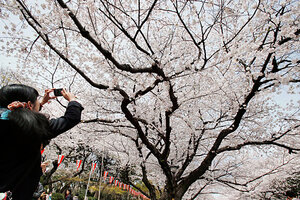Japan's weak currency means tourism
The number of tourists coming to Japan dropped dramatically after the Fukushima nuclear disaster in 2011. But between the weak currency and fading memories of the disaster, tourism saw a record high last month.

A woman takes a picture of blooming cherry blossoms in Ueno Park in Tokyo, in March. The countries tourism saw a record high last month, according to the Japan National Tourism Organization.
Koji Sasahara/AP/File
Tokyo
Tourists have stayed away in droves in the two years since a deadly triple disaster on Japan's northeast coast, but Japan is mounting a remarkable comeback, with foreign visitor numbers reaching a record high last month.
From April 2012 to April 2013, the number of foreign tourists rose about 18 percent. The record 923,000 visitors surpasses the previous monthly record of 879,000 set in July 2010, according to the Japan National Tourism Organization (JNTO).
The yen's dramatic drop against the US dollar and other major currencies, the availability of cheap international flights, and fading memories of the March 2011 disaster have combined to put Japan back on the tourist map.
Still, tourism officials in Tokyo said they were not entirely satisfied with last month's impressive showing. "The figure isn't bad, but more needs to be done," Norifumi Ide, head of the Japan Tourism Agency, told reporters this week.
Japan has set itself a target of 10 million visitors this year, having seen numbers plummet in the wake of the earthquake, tsunami, and Fukushima Daiichi nuclear power plant meltdown on March 11, 2011.
In April that year, during the normally busy cherry blossom-viewing season, visitor numbers fell by a staggering 63 percent from the same month the previous year. Tourists were deterred by frequent aftershocks rattling Tokyo, and by fears of radiation, despite official reassurances that the capital and popular destinations such as Kyoto were safe.
Ambitious tourism plans?
The disaster forced Japan to abandon plans to attract 25 million visitors a year by 2020. But Prime Minister Shinzo Abe recently outlined a target of 20 million tourists a year by 2017, more than double current levels, partly through relaxing visa regulations for people from certain countries.
Tourism authorities are hoping to launch a new round of campaigns in partnership with Japanese embassies and other public and private bodies focusing on "cool Japan," including its food and drink, manga comics, and other staples of the country's popular culture, according to Mamoru Kobori, executive director of marketing and promotion at the JNTO in Tokyo.
"The April figure for total inbound visitors to Japan is a new record, and we're encouraged by that," says Mr. Kobori. "But we are still short of our annual target by about two percentage points."
Tourists from the US and Europe have Mr. Abe partly to thank for making Japan less of a drain on their finances, although traveler tales of Tokyo's prohibitively expensive restaurants and hotels ignore the many cheaper options available to visitors.
Abe’s policies have successfully weakened Japan's currency in an effort to bring relief to the country's exporters. The dollar, which was valued at around 80 yen in November, has risen to the 102-yen level in recent days.
No fear
Still, currency shifts were not a factor in Igor Chikin's decision to come to Japan on a 17-day visit that includes stops in Tokyo, Kyoto, Hiroshima, Nagasaki and other cities.
"Friends of ours who have been before told us how beautiful Japan was, so we came here with high expectations," says the Russian during a walk on the grounds of Zojo-ji temple in Tokyo.
Mr. Chikin and his traveling companion, Ina Ekater, say they struggled to adapt to sitting and sleeping on tatami-mat floors during a stay at a ryokan inn in Kyoto. "It's not designed for Europeans", Ms. Ekater says.
But they were otherwise impressed. "We love the food here, particularly the fresh seafood," says Chikin. "It tastes completely different to Japanese food in Russia. The most comfortable and friendly place we've been to so far was Nagasaki."
Ekater confessed to having a mild fear of earthquakes – an ever-present threat in seismically overactive Japan – but neither of them were concerned about the possibility of further trouble at Fukushima Daiichi nuclear power plant. "We experienced Chernobyl, so we don't worry unduly about radiation," Chikin said.
In the past two years, Japan has attempted to dispel fears over radiation levels outside the immediate vicinity of the stricken power plant, inviting about 1,000 journalists and travel industry professionals to see Tokyo and other parts of the country for themselves.
"Travelers now have confidence in Japan's safety," says Kobori. "Then there are the favorable movements in the exchange rate and an increase in flights to Japan from East Asia as a result of the open-sky policy."
Popular tourist destination
By country, South Koreans comprised the single biggest group of tourists, with more than 204,000 making the short journey to Japan last month, up almost 38 percent from last year.
Japan remains a wildly popular destination for South Koreans, despite tensions between Seoul and Tokyo over wartime history and rival claims to the Takeshima islands, known as Dokdo in Korea.
South Koreans were followed by visitors from Taiwan, China, the US, Hong Kong, and Thailand.
While still comparatively high, the number of Chinese visitors to Japan fell last month by 33 percent from 2012, as tourism became the victim of a bitter dispute over the Senkakus, a chain of islands in the East China Sea that are claimed by both countries.
The latest round of tension over the territory – known as Diaoyu in China – began in spring last year, when Japan's decision to buy the islands from their private owner triggered boycotts of Japanese goods and violent protests in Chinese cities.

